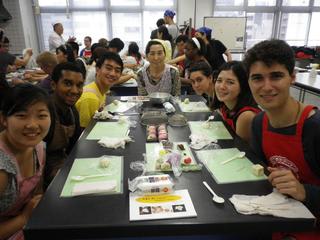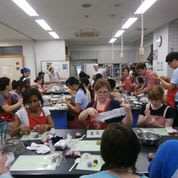
Jo-nama-gashi is the unbaked sweets made from Adzuki(red bean) paste and Nerikiri (made from white bean paste, glutious rice flour, and water)that reflects the distinctive beauty of each season throughout the year.
Jo-nama-gashi is not familiar to the students, because they are commonly served in the tea ceremony with mattya.
Sakamoto-son selected the two motifs reflecting the season, a daisy and an iris.
Daisy Iris
It is not easy to make adzuki bean paste wrapped into the pink nerikiiri paste at the first step of making the motif of daisy flower.


 Furthermore, making the touch of the petal by handling a tool requires the experienced skills.
Furthermore, making the touch of the petal by handling a tool requires the experienced skills.
Though If once you can get the hang of it, it is not so difficult, but elaborate artisan’s skill is necessary to get the finishing touch beautiful.
Have you ever heard the “Chakin-shibori” ?
Cyakin-shibori Cyakin Zushi
It's a traditional technique to squeeze the "chakin"or known as tea cloth(naming from the cloth used at the Tea ceremony) when you make sweets. I wonder You might hear “Chakin Zushi”? That is a sushi wrapped in the layer of fried egg.
We wrapped the paste with the cloth and squeeze the lower part to make the creases on the surface of an Iris flower.
Using our hands, the tips of fingers and the particular tools we have finished the motif of wgashi.
What interests you is even you have the entire same ingredients, you can get the different type of the motifs by changing the finishing touch of different pistils and lea ves . 

We had mattya and original sweets prepared by Mrs. Sakamoto and took out the hand-made wagashia back to home as their souvenirs.




How nice time we shared an experience of the Japanese traditional food culture!!
PS I noticed many students are the big fan of “ Nama-yatsuhashi”
I love it, too!! How about you?
MM

























